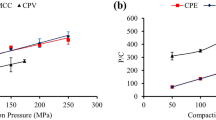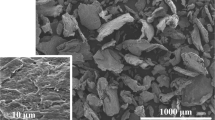Abstract
Cyclodextrins are cyclic carbohydrates widely used as complexing and non-complexing excipients in drug delivery systems. The purpose of this work was to study the ability of hydroxypropyl-β-cyclodextrin and β-cyclodextrin to act as tablet fillers for direct compression. In this way, several parameters of the cyclodextrins were evaluated, namely: (i) the flow properties such as angle of repose, flow time, Carr index, and Hausner ratio; (ii) the compaction behavior, specifically the energies and forces exerted during tableting, the plasticity index, the lubrication efficiency, and compression profiles (force/time and work/displacement of the upper punch); and (iii) the influence on carbamazepine release characteristics from uncoated tablets, i.e., dissolution rate and disintegration time. In addition, these properties of the cyclodextrins were compared with those from other commonly used direct compression fillers (lactose monohydrate, mannitol, calcium hydrogen phosphate dihydrate, and microcrystalline cellulose) and co-processed excipients (microcrystalline cellulose/mannitol and lactose monohydrate/cellulose). Three main conclusions can be drawn: (i) the studied cyclodextrins can be used as tablet fillers for direct compression; (ii) hydroxypropyl-β-cyclodextrin showed better properties than β-cyclodextrin mainly at the level of the physics of compression (higher values of plasticity index and lubrication efficiency) and of the drug release characteristics (faster and greater dissolution rate and a shorter disintegration time); and (iii) lactose monohydrate and hydroxypropyl-β-cyclodextrin displayed the best results. As there are people intolerant to lactose, hydroxypropyl-β-cyclodextrin, although its cost is higher, can be considered a good substitute for lactose.




Similar content being viewed by others
References
Conceição J, Adeoye O, Cabral-Marques HM, Lobo JMS. Cyclodextrins as drug carriers in pharmaceutical technology: the state of the art. Curr Pharm Des. 2018;24:1–29.
Jansook P, Ogawa N, Loftsson T. Cyclodextrins: structure, physicochemical properties and pharmaceutical applications. Int J Pharm. 2018;535(1–2):272–84.
Salústio PJ, Pontes P, Conduto C, Sanches I, Carvalho C, Arrais J, et al. Advanced technologies for oral controlled release: cyclodextrins for oral controlled release. AAPS PharmSciTech. 2011;12(4):1276–92.
Challa R, Ahuja A, Ali J, Khar RK. Cyclodextrins in drug delivery: an updated review. AAPS PharmSciTech. 2005;6(2):E329–57.
Adeoye O, Cabral-Marques H. Cyclodextrin nanosystems in oral drug delivery: a mini review. Int J Pharm. 2017;531(2):521–31.
Gharib R, Greige-Gerges H, Fourmentin S, Charcosset C, Auezova L. Liposomes incorporating cyclodextrin-drug inclusion complexes: current state of knowledge. Carbohydr Polym. 2015;129:175–86.
di Cagno MP. The potential of cyclodextrins as novel active pharmaceutical ingredients: a short overview. Molecules. 2016;22(1). https://doi.org/10.3390/molecules22010001.
Mangal S, Meiser F, Morton D, Larson I. Particle engineering of excipients for direct compression: understanding the role of material properties. Curr Pharm Des. 2015;21(40):5877–89.
Conceição J, Adeoye O, Cabral-Marques HM, Sousa Lobo JM. Cyclodextrins as excipients in tablet formulations. Drug Discov Today. 2018;23(6):1274–84.
Leane M, Pitt K, Reynolds G. A proposal for a drug product manufacturing classification system (MCS) for oral solid dosage forms. Pharm Dev Technol. 2015;20(1):12–21.
Li Z, Lin X, Shen L, Hong Y, Feng Y. Composite particles based on particle engineering for direct compaction. Int J Pharm. 2017;519(1–2):272–86.
Drašković M, Djuriš J, Ibrić S, Parojčić J. Functionality and performance evaluation of directly compressible co-processed excipients based on dynamic compaction analysis and percolation theory. Powder Technol. 2018;326:292–301.
Patel S, Kaushal AM, Bansal AK. Compression physics in the formulation development of tablets. Crit Rev Ther Drug Carrier Syst. 2006;23(1):1–65.
Rojas J, Buckner I, Kumar V. Co-proccessed excipients with enhanced direct compression functionality for improved tableting performance. Drug Dev Ind Pharm. 2012;38(10):1159–70.
Cyclodextrins used as excipients. London: European medicines agency (EMA), Committee for Human Medicinal Products (CHMP); 2017.
Kovacević I, Parojcić J, Homsek I, Tubić-Grozdanis M, Langguth P. Justification of biowaiver for carbamazepine, a low soluble high permeable compound, in solid dosage forms based on IVIVC and gastrointestinal simulation. Mol Pharm. 2009;6(1):40–7.
European Pharmacopoeia (Ph. Eur.). 9th edition. Strasbourg: European Directorate for the Quality of Medicines and HealthCare (EDQM); 2017.
Carr RL. Evaluating flow properties of solids. Chem Eng. 1965;72:163–8.
Carr RL. Powder and granule properties and mechanics. Chem Eng. 1976;8:13–88.
Hausner H. Friction conditions in a mass of metal powder. Int J Powder Metall. 1967;3:7–13.
Stamm A, Mathis C. Verpressbarkeit von festen Hilfsstoffen für Direkttablettierung. Acta Pharm Technol. 1976;22:7–16.
Jones TM. The physicochemical properties of starting materials used in tablet formulation. Int J Pharm Tech Prod Manuf. 1981;2:17–24.
Fell JT, Newton JM. Determination of tablet strength by the diametral-compression test. J Pharm Sci. 1970;59(5):688–91.
Portuguese Pharmacopoeia 9.0. Lisbon: INFARMED, Health Ministry; 2008.
Costa P, Sousa Lobo JM. Modeling and comparison of dissolution profiles. Eur J Pharm Sci. 2001;13(2):123–33.
Morais JA, Lobato MDR. The new European medicines agency guideline on the investigation of bioequivalence. Basic Clin Pharmacol Toxicol. 2010;106(3):221–5.
Wang J, Wen H, Desai D. Lubrication in tablet formulations. Eur J Pharm Biopharm. 2010;75(1):1–15.
Aulton ME, Taylor KMG. Aulton's pharmaceutics: the design and manufacture of medicines. 4th ed. London: Churchill Livingstone; 2013.
Fenyvesi E, Takayama K, Szejtli J, Nagai T. Evaluation of cyclodextrin polymer as an additive for furosemide tablet. Chem Pharm Bull (Tokyo). 1984;32(2):670–7.
Fenyvesi E, Shirakura O, Szejtli J, Nagai T. Properties of cyclodextrin polymer as a tabletting aid. Chem Pharm Bull (Tokyo). 1984;32(2):665–9.
Zimmer Ł, Kasperek R, Poleszak E. Application of β-cyclodextrin in the formulation of ODT tablets containing ibuprofen. Polim Med. 2014;44(4):231–5.
Late SG, Banga AK. Response surface methodology to optimize novel fast disintegrating tablets using β cyclodextrin as diluent. AAPS PharmSciTech. 2010;11(4):1627–35.
Motoyama K, Nagatomo K, Abd Elazim SO, Hirayama F, Uekama K, Arima H. Potential use of 2-hydroxypropyl-beta-cyclodextrin for preparation of orally disintegrating tablets containing dl-alpha-tocopheryl acetate, an oily drug. Chem Pharm Bull (Tokyo). 2009;57(11):1206–12.
Garcia-Fernandez MJ, Tabary N, Chai F, Cazaux F, Blanchemain N, Flament MP, et al. New multifunctional pharmaceutical excipient in tablet formulation based on citric acid-cyclodextrin polymer. Int J Pharm. 2016;511(2):913–20.
Tan G, Morton DA, Larson I. On the methods to measure powder flow. Curr Pharm Des. 2015;21(40):5751–65.
Adeoye O, Alebiowu G. Flow, packing and compaction properties of novel coprocessed multifunctional directly compressible excipients prepared from tapioca starch and mannitol. Pharm Dev Technol. 2014;19(8):901–10.
Sousa e Silva JP, Splendor D, Gonçalves IMB, Costa P, Sousa Lobo JM. Note on the measurement of bulk density and tapped density of powders according to the European pharmacopeia. AAPS PharmSciTech. 2013;14(3):1098–100.
Crouter A, Briens L. The effect of moisture on the flowability of pharmaceutical excipients. AAPS PharmSciTech. 2014;15(1):65–74.
Liu LX, Marziano I, Bentham AC, Litster JD, White ET, Howes T. Effect of particle properties on the flowability of ibuprofen powders. Int J Pharm. 2008;362(1–2):109–17.
Conceição J, Teixeira C, Sousa G, Simões AM, Amorim A, Sá B, et al. Tablet machine instrumentation: influence of lubricants on the lubrication efficiency and compaction profiles. Arh farm. 2016;66:111–2.
Conceição J, Sousa G, Teixeira C, Simões AM, Sá B, Sousa Lobo JM. Influence of lubricants on tabletting and drug release characteristics. In: 10th world meeting on pharmaceutics, biopharmaceutics and pharmaceutical technology. Glasgow: APV, APGI and A.D.R.I.T.E.L.F; 2016.
Pitt KG, Heasley MG. Determination of the tensile strength of elongated tablets. Powder Technol. 2013;238:169–75.
Doelker E, Massuelle D. Benefits of die-wall instrumentation for research and development in tabletting. Eur J Pharm Biopharm. 2004;58(2):427–44.
Markl D, Zeitler JA. A review of disintegration mechanisms and measurement techniques. Pharm Res. 2017;34(5):890–917.
Desai PM, Liew CV, Heng PWS. Review of disintegrants and the disintegration phenomena. J Pharm Sci. 2016;105(9):2545–55.
Ferrari F, Bertoni M, Bonferoni CM, Rossi S, Caramella C, Bolhuis GK. Dissolution enhancement of an insoluble drug by physical mixture with a superdisintegrant: optimization with a simplex lattice design. Pharm Dev Technol. 1996;1(2):159–64.
Acknowledgements
Jaime Conceição is grateful to Fundação para a Ciência e a Tecnologia (FCT) and PhD Programme in Medicines and Pharmaceutical Innovation (i3DU) for funding this work through the scholarship with the reference PD/BD/127813/2016. To Roquette®, Meggle Excipients & Technology, JRS Pharma, and FMC Health and Nutrition for supplying free samples of the excipients.
Author information
Authors and Affiliations
Corresponding author
Rights and permissions
About this article
Cite this article
Conceição, J., Adeoye, O., Cabral-Marques, H.M. et al. Hydroxypropyl-β-Cyclodextrin and β-Cyclodextrin as Tablet Fillers for Direct Compression. AAPS PharmSciTech 19, 2710–2718 (2018). https://doi.org/10.1208/s12249-018-1115-z
Received:
Accepted:
Published:
Issue Date:
DOI: https://doi.org/10.1208/s12249-018-1115-z




